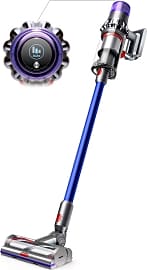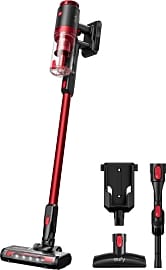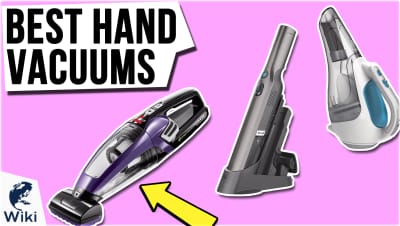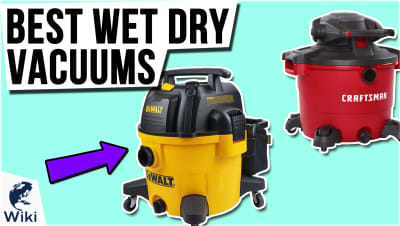The 9 Best Stick Vacuums

This wiki has been updated 41 times since it was first published in March of 2015. When you want to pick up a mess quickly without having to drag out a heavy, full-size vacuum cleaner, these compact and lightweight stick models are perfect. They’re small enough to keep close at hand, with some featuring convenient, wall-mounted docking stations. Many convert into handheld dust busters, and several boast impressive suction power that rivals that of their bigger cousins. When users buy our independently chosen editorial choices, we may earn commissions to help fund the Wiki.
Editor's Notes
June 25, 2021:
A few important updates to note. The Miele Triflex HX1 is our new #1 and the Dyson V11 Torque Drive has fallen a few spots because it's awfully expensive and not as versatile as the Miele. We also upgraded to the Hoover ONEPWR Evolve, which is an excellent mid-range cordless model. The Eufy by Anker HomeVac S11 Lite is another new addition, and while it's not most powerful, it's relatively lightweight and doesn't cost a fortune. If you really want to save money, though, both the Bissell Featherweight and Dirt Devil Simpli-Stik are straightforward, dependable, and affordable.
January 18, 2020:
Today’s update replaces several items with updated, more powerful versions, including the newly added Dyson V11 Torque Drive, which packs more power than previously, for a suction that rivals even some corded models. Its high-torque cleaner head intelligently adapts to carpet or hard floors, without your having to manually change any settings. You’ll appreciate its color-coded LCD that’s right on top of the handle, with green for Eco mode, blue for Auto mode and red for Boost mode. It also provides a countdown of the remaining run time, a reminder when it’s time to clean the filter, and useful alerts when there are any blockages, with information on how to clear them. It can capture up to 99.97% of microscopic dust particles, with 14 cyclones to fling them into the bin. While actual run time will vary based on the attachments you’re using, you can get up to 60 minutes of fade-free floor cleaning per charge. It transforms in seconds to a convenient handheld model and is equipped with a wall-mounted docking station for easy storage.
For a significantly less expensive model that’s also a force to be reckoned with, look to the Shark Apex DuoClean, which incorporates a dual brush roll system for powerful pickup of pet hair and debris on floors, carpets, stairs, and furniture. Its bright LED headlights help you to see and pick up hidden debris, and its smooth swivel steering helps you maneuver into tight corners, beneath furniture, and around the legs of tables and chairs.
The Black & Decker Cordless is great for handling either floors or messes on countertops or between furniture cushions. It’s got a powered beater bar that agitates dust and debris in carpets for a deep-down clean, and this component is easily removable for quick maintenance. If you’re trying to clean hard-to-reach areas like ceilings, just remove the onboard extension tool and attach it. Its patented smart sensors can keep you apprised of the remaining battery life and let you know when it’s time to clean the filter.
If you’re interested in seeing additional cordless models, check out our list of best cordless vacuums for more conveniently chargeable options that can make it to every corner of your house, without your having to keep stopping and plugging in the cord in a new outlet.
Suction Without The Stress
Most of these vacs work on the same principles as any other vacuum cleaner.
A vacuum cleaner can be a peaceful thing. As a baby, I needed noise to fall asleep, the more droning and consistent the better. Car rides with the windows down, televisions set to static, ocean waves, crickets, and vacuum cleaners running in the next room made up the soundtrack of my early slumbers.
Those were the behemoth vacuums of the 1980s, which sometimes seemed bigger than the rooms they were meant to clean. One of the most advantageous aspects of the stick vacuums we are reviewing here is that they are extraordinarily slight. They take up extremely little space in storage, and they run much more quietly than the vacuums of yore.
Most of these vacs work on the same principles as any other vacuum cleaner. They create suction by the movements of a small pump system connected to a belt that’s run by a very fast motor. As the motor turns, the belt rotates and moves the pump through its cylinder. The suction this creates also creates an opposite force that you can feel as an air current coming out of the upper parts of the motor.
To help pick up hairs, dust, and debris, each vacuum has a series of stiff nylon bristles clustered at the end of its mouth, where the suction hits the floor. Additional filters trap much smaller dust particles, preventing the projection of allergenic material out of the vacuum’s vents.
The difference between a stick vacuum and any other vacuum, however, lies in the ergonomics of its design. The long, thin shape used by these models allows you to gain access to tighter areas for a more thorough cleaning. The vacuums are also lighter as a result of their streamlined design, so raising them up to clean tough-to-reach areas is much easier, as is their transportation, storage, and cleaning.
The Clean, Clear Choice
I’ll always remember the commercials for the Oreck vacuum cleaner that aired when I was a kid. In them, the inventor of the unit, into his old age, stood before the cameras holding his vacuum aloft with just his pinky finger. The point was that his vacuum was so significantly lighter than its competition that you’d be that much more blown away by its suction power.
Compared the powerful stick vacuums on our list, the original Oreck seems a bit like a dinosaur in the age of man. The units on the market today boast just as much power, however, and most weigh less than that old Oreck.
I’ll always remember the commercials for the Oreck vacuum cleaner that aired when I was a kid.
Weight is the easy measure to understand here, but how exactly does the vacuum industry evaluate the suction force of a cleaner? Than answer is air watts.
Air watts are measured by the amount of suction a vacuum cleaner imposes on a certain amount of water moving through a specific diameter tube. The larger that amount, the better, as it means the vacuum cleaner moves more water through the tube more consistently, which will result in a faster, more thorough cleanup in your home.
Still, weight and air watts aren’t the totality of the picture. You also want to see how a given stick vacuum feels in your hand if you get the chance. Models with their motors and chambers mounted down toward the vacuum head (the more standard configuration) will be easier to push and pull along a carpet, as they have that bottom-heavy stature aiding in their inertia.
Models with motors situated toward the handles, however, might need a little more elbow grease when moving them along a thick, tough carpet. The advantage of such a vacuum is that it’s much easier to pick up if you want to use it on a bed, on some drapes, or anywhere else up high that’s hard to reach with a normal vacuum.
Take a close look at the space you intend to clean before making your choice, and you ought to do just fine.
An Evolution Back Towards Simplicity
While the first vacuum cleaners that actually produced suction by mechanical means came out in the middle of the 19th century, they were manually operated, and motorized vacs wouldn't hit the scene until 1901. That's when an inventor named Hubert Cecil Booth improved upon the motorized cleaner he'd seen at a demonstration a few years earlier at Empire Music Hall in London.
That earlier design blew dust into a receptacle instead of sucking it up into a bag for later disposal, and it was Booth that turned the process around.
That earlier design blew dust into a receptacle instead of sucking it up into a bag for later disposal, and it was Booth that turned the process around. Those early vacs operated by the power of combustion engines, and a lone hose ran from the engine–which was usually located outside the house–to a wand for directional cleaning.
By 1905, smaller, albeit weaker, models made their way into the wealthier homes of England. What they sacrificed in power they made up for in portability, as these proved to be the first domestically convenient vacuums available. Still, it wasn't until 1907 that anyone successfully ran a portable vacuum with electricity instead of gas.
The elongated wands used in the design of old, domestic vacuums more closely resembles the stick vacuums that are so popular today than the bigger bulkier vacs of the late 20th century. Advances in vacuum power are the primary drivers of this trend toward a slighter, thinner style, and there's no reason to believe we won't soon see the larger vacuums of the 80s and 90s disappear from the market altogether.














